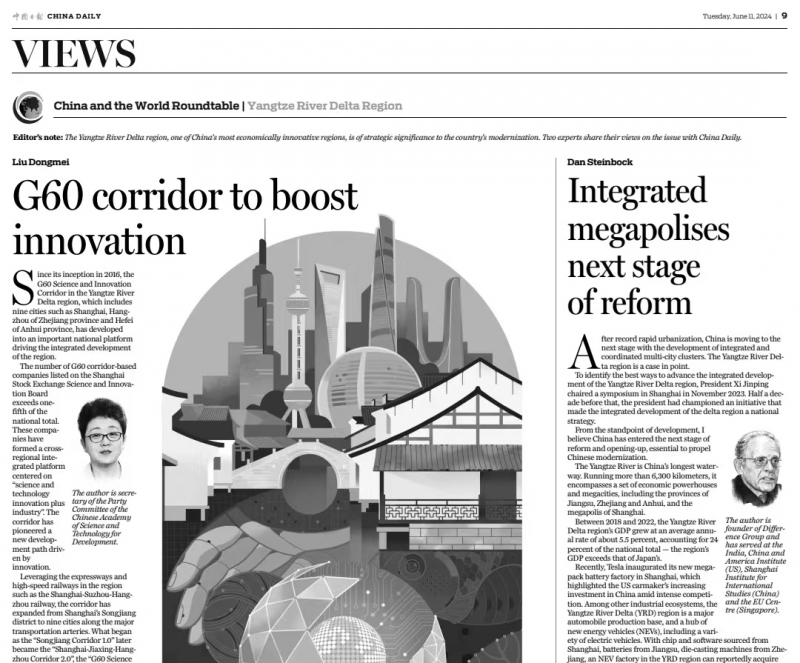【中国日报英文版(CHINA DAILY)】刘冬梅: G60 corridor to boost innovation

Since its inception in 2016, the G60 Science and Innovation Corridor in the Yangtze River Delta region, which includes nine cities such as Shanghai, Hangzhou of Zhejiang province and Hefei of Anhui province, has developed into an important national platform driving the integrated development of the region.
The number of G60 corridor-based companies listed on the Shanghai Stock Exchange Science and Innovation Board exceeds one-fifth of the national total. These companies have formed a cross-regional integrated platform centered on "science and technology innovation plus industry". The corridor has pioneered a new development path driven by innovation.
Leveraging the expressways and high-speed railways in the region such as the Shanghai-Suzhou-Hangzhou railway, the corridor has expanded from Shanghai's Songjiang district to nine cities along the major transportation arteries. What began as the "Songjiang Corridor 1.0" later became the "Shanghai-Jiaxing-Hangzhou Corridor 2.0", the "G60 Science and Innovation Corridor", and ultimately the G60 Science and Innovation Corridor, which now comprises nine cities in the Yangtze River Delta region.
The focus of the G60 corridor is now on "integration" and "high quality". It aims to synergize the industrial and governance systems, in order to transform "Made in China" into "Created in China" based on technological and institutional innovation.
To address challenges such as loose organizational forms and local governments' lack of motivation for cooperation, and to leverage China's unique advantages in government leadership and boost intergovernmental cooperation, the G60 corridor has built a multilayered governance network.
First, the interactions between central and local governments guide multilevel government coordination. Empowered by the central government, local governments and the G60 corridor employ a "top-down interactive" strategy to coordinate with relevant ministries to enhance the corridor's policy advantages.
Second, to boost cross-regional cooperation and intergovernmental cooperation, the nine cities have adjusted and integrated their administrative mechanisms, breaking the administrative barriers. The Ministry of Science and Technology, the National Development and Reform Commission, the Ministry of Industry and Information Technology, the People's Bank of China, the China Banking and Insurance Regulatory Commission and the China Securities Regulatory Commission have formed a special working group to help build the G60 corridor, with the group being jointly led by the Ministry of Science and Technology and relevant Shanghai government departments.
In addition, after its establishment, the operational office of the G60 Science and Innovation Corridor Joint Conference has issued documents such as the "Work System of the G60 Science and Innovation Corridor Joint Conference in the Yangtze River Delta". The nine cities, too, have established G60 promotion offices, boosting information and cadre exchanges, and promoting resource sharing and win-win cooperation.
The G60 corridor will establish a mechanism to address the problem of homogeneous industrial development in adjacent regions, make regional resource utilization more efficient, boost collaborative industrial development, and promote the integration of industry chains across regions.
Besides, coordinated planning has led to rapid industrial development in the nine cities. Aiming to build advanced industrial systems, the nine cities have jointly issued the "14th Five-Year Plan for Advanced Manufacturing Collaborative Development in the Yangtze River Delta region" and a list of core technology research subjects to realize differential development across regions.
Spatial layout planning plays a key role in industrial development and project landing. To promote resource integration and share high-quality scientific and technological resources, the nine cities are focusing on strategic emerging industries and "specialized and new" small and medium-sized enterprises, establishing 16 industrial (park) alliances and 13 industrial cooperation demonstration zones. They have also taken measures to ensure the high-quality development of industry chains in sectors such as auto parts, biomedicine and intelligent logistics equipment.
Playing a significant role in directly meeting market demands, linking upstream and downstream resources in industry chains, and enhancing the stability and competitiveness of regional industry chains, leading enterprises are driving the free flow of elements in the region, prompting thousands of enterprises in the nine cities to join the G60 large aircraft supplier reserve pool and build a cluster of hundreds of industry chain cooperative enterprises for SMIC International.
To boost the advantage of the Yangtze River Delta region in innovations, address the problem of cross-regional R&D in technology, and promote the scientific and technological resource sharing, the G60 corridor has developed a diversified scientific and technological innovation matrix.
National-level science hubs in Hefei, Anhui province, national biopharmaceutical technology innovation centers in Suzhou, Jiangsu province, and other major R&D platforms, as well as the Songjiang G60 Brain Intelligence Science and Innovation Base, the Cohen Laboratory and the Uto Laboratory have been turned into innovation centers.
The implementation of the "Action Plan for Jointly Tackling Key Technologies" in the G60 corridor, and the strategic cooperation projects between the nine cities and the Shanghai Institutes for Advanced Studies of the Chinese Academy of Sciences, and the Shanghai Academy of Sciences have resulted in major scientific and technological achievements.
While the first cross-regional scientific and technological achievement transformation fund in the Yangtze River Delta region has been created, the five auctions for the products created in the G60 corridor have cumulatively yielded 18 billion yuan ($2.48 billion).
To prevent local governments from formulating different investment attraction policies with varying degrees of preferential treatment and subsidies, the G60 corridor has strengthened the unified policy to ensure the smooth cross-regional flow of innovation elements. What has helped the process is the establishment of the "One Network Office" mechanism, which covers all the nine cities and comprises 89 comprehensive service windows, and its designation by the State Council, China's Cabinet, as the first batch of pilot areas for comprehensive government service in the Yangtze River Delta region.
The three provinces and one city-Jiangsu, Zhejiang and Anhui provinces, and Shanghai — in the Yangtze River Delta region have jointly issued 28 financial support policies, improving the matrix of financial products such as G60 science and technology loan, park loan, quality loan, standard loan, and talent loan, using the Shanghai Stock Exchange's capital market to promote the development of the G60 corridor.
As such, the future of the G60 corridor looks bright.
The author is secretary of the Party Committee of the Chinese Academy of Science and Technology for Development. The views don't necessarily reflect those of China Daily.
If you have a specific expertise, or would like to share your thought about our stories, then send us your writings at opinion@chinadaily.com.cn, and comment@chinadaily.com.cn.
(原文链接: https://enapp.chinadaily.com.cn/a/202406/11/AP66678164a310115ef06755f7.html)
 联系我们
联系我们
地址:中国 北京市海淀区玉渊潭南路8号 邮编(ZIP):100038
电话(Tel):86-10-58884543 咨询:webmaster@casted.org.cn 新闻与信息:xxxz@casted.org.cn
![]() 版权所有 中国科学技术发展战略研究院 备案号/经营许可证备号:京ICP备10036465号-11
技术支持:中研网
版权所有 中国科学技术发展战略研究院 备案号/经营许可证备号:京ICP备10036465号-11
技术支持:中研网




